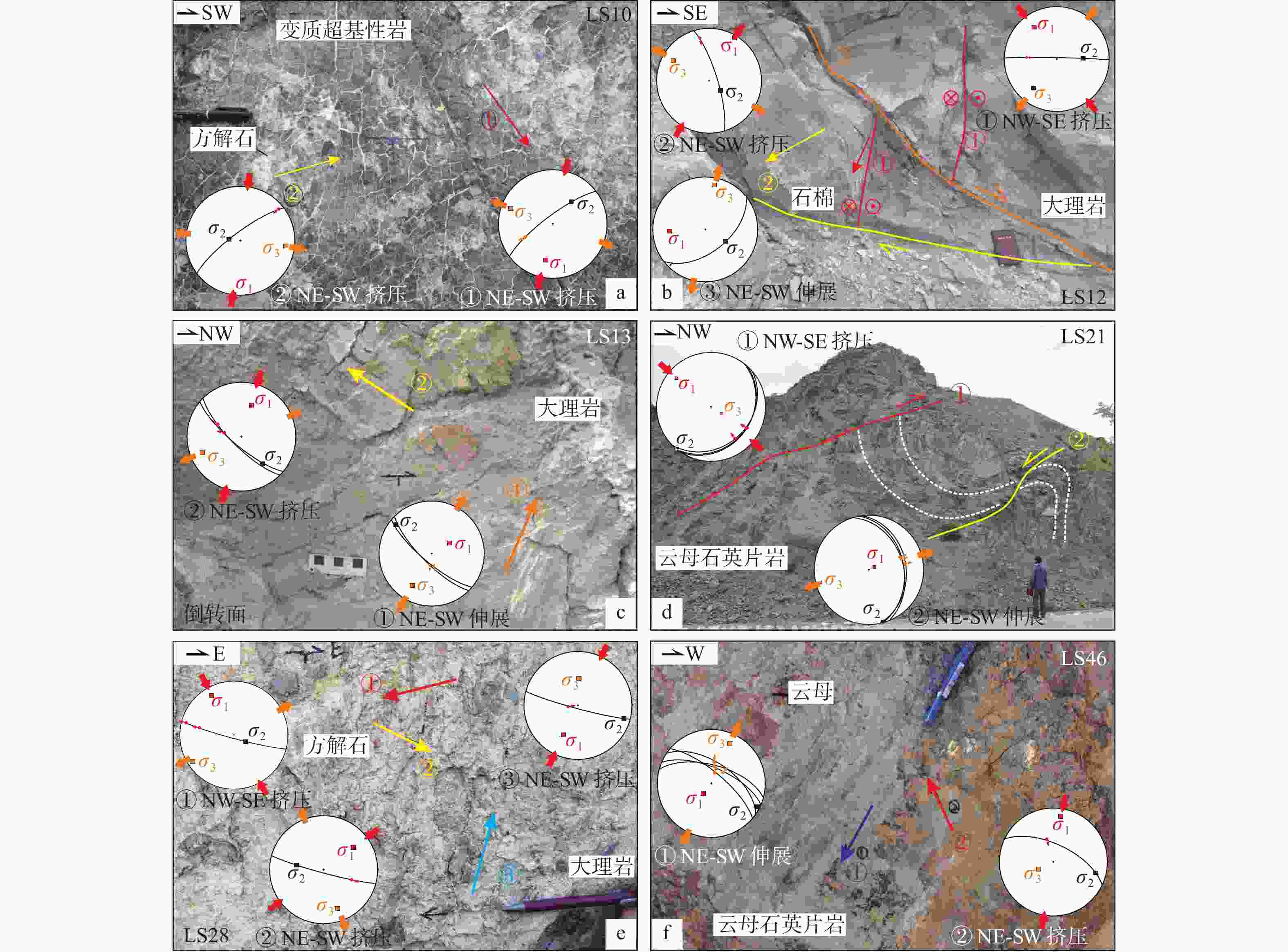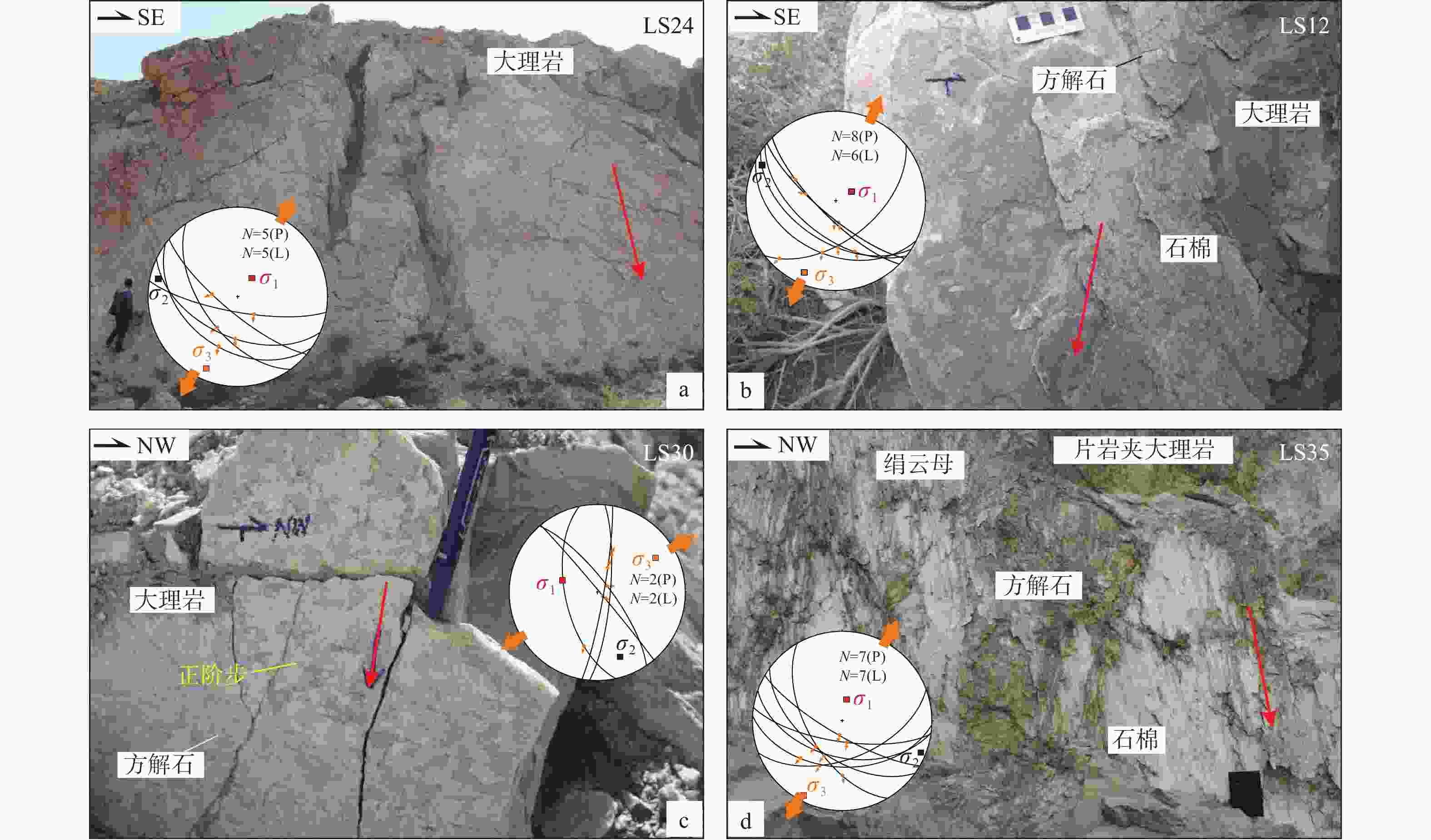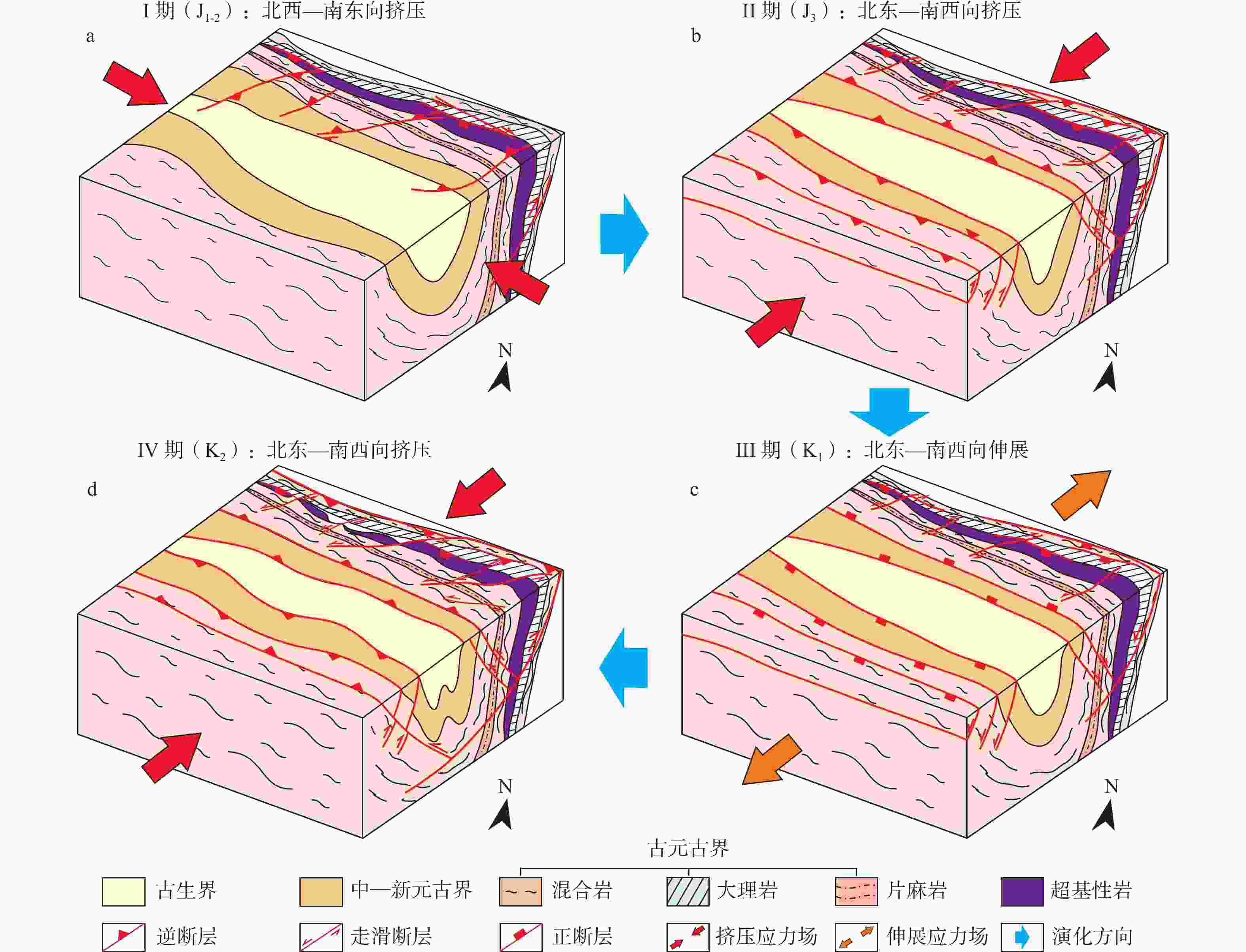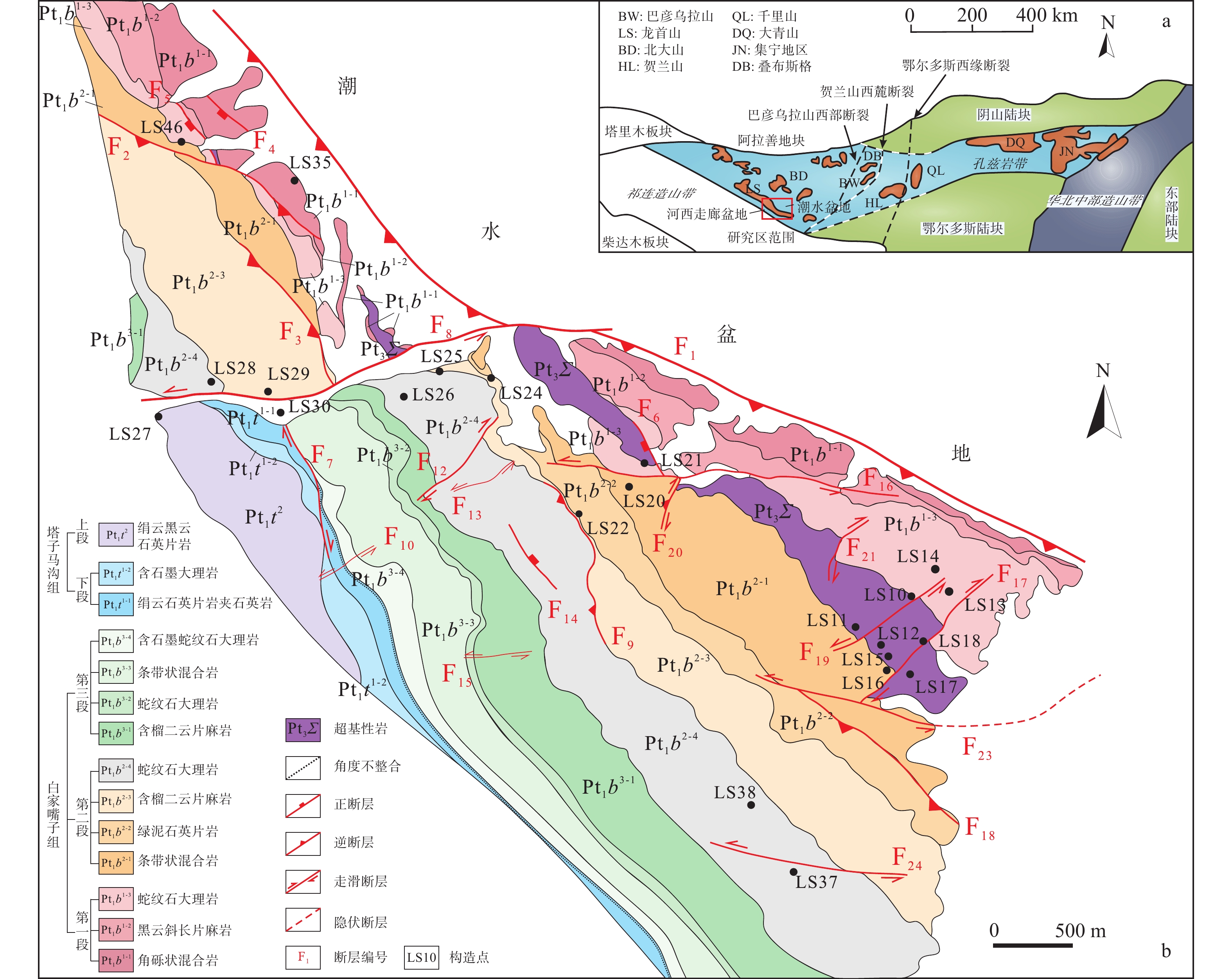Study on the reconstruction of the paleo-tectonic stress field and its evolution in the Jinchuan mining district, Gansu Province, China
-
摘要: 金川矿区经历了复杂的构造演化历史,目前其成矿期后的构造变形特征和应力场演化阶段仍缺乏精细剖析。文章运用构造解析方法对金川矿区地表基岩中的断层进行了分期和配套,确定了构造变形序列,认为矿区存在4组重要的断层组合,包括北东向逆冲断层和北西向走滑断层、北东向走滑断层和北西向逆冲断层、北西向正断层以及北东东向走滑断层。通过研究断层破裂面及擦痕构造,利用赤平投影法恢复了断层的古构造应力场,结合区域大地构造演化历史,准确限定了金川矿区成矿期后的应力场演化阶段,对认识区域构造演化和开发新远景区具有重要意义。结果显示,金川矿区在成矿期后经历了4期古构造应力场作用,表现为多阶段不同方向的挤压和伸展过程,分别响应了区域中生代以来的一系列构造热事件,Ⅰ期表现为早—中侏罗世的北西—南东向挤压应力场,Ⅱ期为晚侏罗世的北东—南西向挤压应力场,Ⅲ期为早白垩世的北东—南西向伸展应力场,Ⅳ期为晚白垩世以来的北东—南西向挤压应力场。Abstract: The Jinchuan mining district has undergone a complex tectonic evolution history, and detailed analysis of the post-mineralization deformation characteristics and stress field evolution stages needs to be completed. This paper employs structural analysis methods to stage and correlate the faults in the bedrock of the Jinchuan mining district, determining the structural deformation sequence. It identifies four significant fault combinations in the region, including NE-trending thrust faults and NW-trending strike-slip faults, NE-trending strike-slip faults and NW-trending thrust faults, NW-trending normal faults, and NEE-trending strike-slip faults. The paleo-tectonic stress field of fault is reconstructed by using the lower hemisphere stereographic projection method on the base of studying faults and striations. Combining the paleo-tectonic stress field results with the regional tectonic evolution history, the study accurately defines the stress field evolution stages in the Jinchuan mining district after the mineralization period, which is crucial for understanding regional tectonic evolution and the development of new prospective areas. The results indicate that the Jinchuan mining district experienced four phases of paleo-tectonic stress field after the mineralization period, characterized by multi-stage compression or extension in different directions. These phases responds to a series of regional tectonic thermal events since the Mesozoic respectively: Phase I exhibits a NW–SE compression stress field during the early to middle Jurassic (J1-2); Phase II shows a NE–SW compression stress field during the late Jurassic (J3); Phase III reflects a NE–SW extensional stress field during the Early Cretaceous (K1); Phase IV represents a NE–SW compression stress field since the Late Cretaceous (K2).
-
图 1 研究区大地构造位置和地质简图
a—研究区大地构造位置图(据Wan et al.,2009修改);b—研究区地层和构造格架简图(据汤中立和李文渊,1995修改)
Figure 1. Geological map and tectonic setting of the study area
(a) Map of the tectonic setting in the study area (modified after Wan et al., 2009);(b) Geological map of the study area (modified after Tang and Li, 1995)
图 2 不同构造点的古构造应力特征
σ1、σ2和σ3分别为最大、中间和最小主应力轴,数字代表应力轴倾向和倾角(°);P代表擦痕;L代表断层面;N为统计数量,(下图同);红色箭头代表挤压方向;橙色箭头代表伸展方向
Figure 2. Features of paleo-tectonic stress at different points
σ1, σ2 and σ3 represent the maximum, intermediate and minimum principal stress axes respectively, the number represents inclination and dip angle of the stress axis; P represents striation, L represents fault plane, N represents statistical quantity; The red arrows represent the direction of compression, and the orange arrows represent the direction of extension.
图 3 断层交切关系和叠加擦痕特征
长箭头代表擦痕和对盘运动方向,数字①、②和③分别代表对应照片中的断层或擦痕期次;赤平投影图中红色箭头代表挤压方向,橙色箭头代表伸展方向a—LS10大理岩中倾向北西的断层面,早期擦痕显示为左旋斜滑运动,晚期擦痕显示为左旋走滑运动;b—LS12大理岩中发育3组断层,第1期为近东西向右旋走滑断层,第2期为北西向右旋走滑断层,第3期为北东向正断层;c—LS13大理岩中向南西陡倾的断层面,早期陡倾擦痕显示为上盘向南西的下滑,晚期缓倾擦痕显示为右旋走滑运动;d—LS21云母石英片岩中发育2组断层及牵引褶皱,早期为倾向南东的逆冲断层,晚期为倾向北东东的正断层;e—LS28大理岩中向南西陡倾的断层面发育3组擦痕,新生矿物为方解石,第1期擦痕指示右旋走滑运动,第2期擦痕指示左旋走滑运动,第3期擦痕指示向北东的逆冲;f—LS46云母石英片岩中倾向北东的断层面,早期擦痕指示上盘向北东下滑,晚期擦痕指示上盘向南的逆冲
Figure 3. The characteristics of fault intersection and superimposed striation
(a) LS10 shows the fault dip to the NW developed in metamorphosed ultramafic rocks; the early striation indicates sinistral strike-slip motion associated with normal faulting, and the late striation indicated sinistral strike-slip motion; (b) LS12 shows three groups of faults developed in marble; the first group of faults with near E–W orientation shows dextral strike-slip motion, the second group of faults with NW orientation indicated dextral strike-slip motion, and the third stage is normal faults on NE orientation; (c) LS13 shows the fault dip to the SW developed in marble; the early striation indicated the top-to-the-SW downslide of the hanging wall, and the late striation show the dextral strike-slip motion; (d) LS21 shows two groups of faults with traction folds developed in mica-quartz schist; the early fault indicated the top-to-the NW thrust of the hanging wall, while the late fault indicated the top-to-the NEE downslide of the hanging wall; (e) LS28 shows three groups of striation developed on the fault dip to the SW with mineral represented by calcite in marble; The striation of the first stage indicated dextral strike-slip motion, the striation of the second stage indicated sinistral strike-slip motion, and the striation of the third stage indicated the top-to-the-NE thrust; (f) LS46 shows the NE trending fault developed in mica-quartz schist, early striation indicated the top-to-the NE downslide of the hanging wall, late striation indicate the top-to-the S thrust of the hanging wall. The long arrow represents the direction of striation and the motion of fault wall; Number ①, ② and ③ represent the stages of faults or striation in corresponding photo; In the stereographic projection, the red arrow represents the direction of compression while the orange arrow represents the direction of extension.
图 4 北西—南东向挤压应力场形成的变形特征
长箭头代表擦痕方向,①和①’代表共轭断层的两组断层面;赤平投影图中的红色箭头代表挤压方向,橙色箭头代表伸展方向a—LS17片麻状花岗岩中发育北西向右旋走滑断层,可见断层镜面和近水平擦痕构造;b—LS18片麻状花岗岩中近南北向左旋走滑断层和近东西向右旋走滑断层组成共轭断层;c—LS20大理岩中北西向右旋走滑断层和近东西向左旋走滑断层组成共轭断层;d—LS25大理岩中的不对称透镜体构造,指示上盘向南东方向逆冲
Figure 4. Typical deformation features under the NW–SE compression
(a) LS17 shows the NW-trending dextral strike-slip fault developed in granitic gneiss with fault polish and low-angle striation; (b) LS18 shows the conjugated fault consists of the NS-trending sinistral strike-slip fault and the EW-trending dextral strike-slip fault developed in granitic gneiss; (c) LS20 shows the conjugated fault consists of the NW-trending dextral strike-slip fault and the EW-trending sinistral strike-slip fault developed in marble; (d) LS25 shows the asymmetric lens developed in marble indicated the top-to-the SE thrust of the hanging wall. The long arrow represents the direction of striation and the motion of fault wall; Number ① and ①’ represent the striation of the conjugated fault; In the stereographic projection, the red arrow represents the direction of compression while the orange arrow represents the direction of extension.
图 5 北东—南西向挤压应力场(早期)形成的变形特征
长箭头代表擦痕及对盘运动方向;赤平投影图中红色短箭头代表挤压方向,橙色箭头代表伸展方向a—LS16-2片麻状花岗岩中左旋走滑断层,断面上可见缓倾擦痕及正阶步构造;b—LS27大理岩中北东向左旋走滑断层带内的多米诺构造,断面发育缓倾擦痕;c—LS22大理岩中北西向逆冲断层组成破碎带和断层泥; d—LS11片麻岩夹大理岩地层中形成轴向南东的褶皱。
Figure 5. Typical deformation features under the NE–SW compression (early stage)
(a) LS16-2 shows the sinistral strike-slip fault developed in granitic gneiss with fault step and low-angle striation on the fault plane; (b) LS27 shows the NE-trending sinistral strike-slip fault developed in marble with domino structures and low-angle striation; (c) LS22 shows the NW-trending thrust fault developed in marble with fracture zone and fault gouge; (d) LS11 shows the fold with axis dip to SE developed in gneiss with marble.The long arrow represents the direction of striation and the motion of fault wall; In the stereographic projection, the red arrow represents the direction of compression while the orange arrow represents the direction of extension.
图 6 北东—南西向伸展应力场形成的变形特征
长箭头代表擦痕及对盘运动方向;赤平投影图中橙色箭头代表伸展方向a—LS24大理岩中北西向的正断层局部组成断层镜面;b—LS13大理岩中北西向正断层,出现石棉和方解石等新生矿物;c—LS30大理岩中北西西向正断层发育方解石为主的新生矿物,正阶步指示上盘向北东方向下滑;d—LS35大理岩中北西西向正断层及擦痕,具新生的石棉、绢云母和方解石等矿物
Figure 6. Typical deformation features under the NE-SW extension
(a) LS24 shows the NW-trending normal fault developed in marble with fault polish; (b) LS13 shows the NW-trending normal fault developed in marble with new-born minerals of calcite and asbestos; (c) LS30 shows the NWN-trending normal fault developed in marble with new-born mineral of calcite, the positive fault step indicated the top-to-the NE downslide of the hanging wall; (d) LS35 shows the NWW-trending normal fault developed in marble with new-born minerals of asbestos, sericite and calcite. The long arrow represents the direction of striation and the motion of fault wall; The orange arrow represents the direction of extension in the stereographic projection.
图 7 北东—南西向挤压应力场(晚期)形成的变形特征
长箭头代表擦痕及对盘运动方向,数字①和②代表擦痕期次;赤平投影图中红色短箭头代表挤压方向,橙色箭头代表伸展方向a—LS16-1 片麻状花岗岩逆冲到大理岩之上,主断层面倾向南西;b—LS24花岗岩中北西向左旋走滑断层面及斜向擦痕构造;c—LS37大理岩中北西西向左旋走滑断层面和缓倾的擦痕构造,新生矿物为方解石,局部形成灰黑色炭质;d—LS29大理岩中北西西向断层面上叠加了两组不同方向的擦痕,早期指示左旋走滑而晚期指示上盘向北东的逆冲作用,显示存在两期北东—南西向挤压应力
Figure 7. Typical deformation features under the NE–SW compression (late stage)
(a) LS16-1 shows the thrust of the granitic gneiss as the hanging wall to the marbles as the footwall, the main fault plane dips to the SW; (b) LS24 shows the NW-trending sinistral strike-slip fault developed in granite with oblique striation; (c) LS37 shows the WNW-trending sinistral strike-slip fault and gentle striation developed in marble with new-born calcite and carbon; (d) LS29 shows the superimposition of two groups of striation on the NWW-trending fault plane, the early striation indicated the sinistral strike-slip faulting and the later one indicated the top-to-the NE thrust which showed the existence of two stages of NE–SW compression. The long arrow represents the direction of striation and the motion of fault wall; In the stereographic projection, the red arrow represents the direction of compression while the orange arrow represents the direction of extension.
图 8 金川矿区成矿期后的构造演化模式图
a—Ⅰ期为早—中侏罗世挤压作用,矿区形成北西向走滑断层和北东向逆冲断层;b—Ⅱ期为晚侏罗世的—挤压作用,矿区形成北东向走滑断层,北西向逆冲断层活化;c—Ⅲ期为早白垩世的伸展作用,矿区形成北西向正断层,部分早期断层性质发生反转;d—Ⅳ期为晚白垩世以来的挤压作用,矿区形成北东东向走滑断层,北西向逆断层活化,地层沿北东—南西方向强烈缩短
Figure 8. Tectonic evolution model of Jinchuan mining district since the mineralization
(a) Phase Ⅰ showed a NW–SE compression during the Early to Middle Jurassic, and the mining district mainly formed the NW-trending strike-slip faults and NE-trending thrust faults; (b) Phase Ⅱ showed a NE–SW compression during the Late Jurassic; the NE-trending strike-slip faults were formed and the NW-trending thrust faults were activated in the mining district; (c) Phase Ⅲ showed a NE–SW extension during the Early Cretaceous, the mining district formed the NW-trending normal faults and kinematics of some early faults reversed; (d) Phase Ⅳ showed a NE–SW compression since the Late Cretaceous; the mining district formed a series of NEE-trending strike-slip faults, and the NW-trending thrust faults were activated and the strata were intensely shortened along the NE–SW direction.
表 1 金川矿区叠加变形构造点的断层性质及应力特征
Table 1. Geometry, kinematics and stress features of faults on structural points with superimposition deformation in the Jinchuan mining district
构造点 断层倾向 断层倾角 擦痕侧伏向 擦痕侧伏角 断层性质 新生矿物 应力方向 LS10 313° 81° 253° 64° 左旋斜滑 方解石 北东—南西挤压 40° 15° 左旋走滑 方解石 北东—南西挤压 LS12 2° 87° 93° 10° 右旋走滑 石棉 北西—南东挤压 73° 76° 283° 25° 右旋走滑 石棉 北东—南西挤压 147° 65° 176° 60° 正断层 无 北东—南西伸展 LS13 223° 70° 183° 63° 正断层 石棉 北东—南西伸展 312° 32° 右旋走滑 石棉 北东—南西挤压 LS21 132° 27° 112° 23° 逆冲 无 北西—南东挤压 80° 37° 70° 33° 正断层 无 北东—南西伸展 LS28 196° 83° 264° 12° 右旋走滑 方解石 北西—南东挤压 123° 30° 左旋斜滑 方解石 北东—南西挤压 212° 75° 逆冲 方解石 北东—南西挤压 LS46 26° 64° 60° 52° 正断层 无 北东—南西伸展 334° 55° 逆冲 云母 北东—南西挤压 -
[1] ANGELIER J, 1984. Tectonic analysis of fault slip data sets[J]. Journal of Geophysical Research: Solid Earth, 89(B7): 5835-5848. doi: 10.1029/JB089iB07p05835 [2] DONG X P, LI Z H, JING X H, et al. , 2023. Stratigraphic sequence characteristics and geochronology research progress of the Cenozoic in the arcuate tectonic belt on the northeastern margin of the Tibet Plateau[J]. Journal of Geomechanics, 29(4): 465-484. (in Chinese with English abstract) [3] FAURE M, LIN W, CHEN Y, 2012. Is the Jurassic (Yanshanian) intraplate tectonics of North China due to westward indentation of the North China block?[J]. Terra Nova, 24(6): 456-466. doi: 10.1111/ter.12002 [4] GAO Y L, TANG Z L, SONG X Y, et al. , 2009. Study on genesis of the concealed Cu-rich ore body in the Jinchuan Cu-Ni deposit and its prospecting in depth[J]. Acta Petrologica Sinica, 25(12): 3379-3395. (in Chinese with English abstract) [5] GONG J H, ZHANG J X, YU S Y, 2011. The origin of Longshoushan Group and associated rocks in the southern part of the Alxa block: constraint from LA-ICP-MS U-Pb zircon dating[J]. Acta Petrologica Et Mineralogica, 30(5): 795-818. (in Chinese with English abstract) [6] GONG J H, 2013. Compositions, characteristics, chronological framework and origin of early-Precambrian metamorphic basement in western Alxa block[D]. Beijing: Chinese Academy of Geological Sciences. (in Chinese with English abstract) [7] HE Q J, LAI J Q, MAO X C, et al. , 2019. Tectonic stress field and tectonic evolution in Jinchuan mining district, Gansu province[J]. Contributions to Geology and Mineral Resources Research, 34(2): 265-273. (in Chinese with English abstract) [8] LI C S, XU Z H, DE WAAL S A, et al. , 2004. Compositional variations of olivine from the Jinchuan Ni-Cu sulfide deposit, western China: Implications for ore genesis[J]. Mineralium Deposita, 39(2): 159-172. doi: 10.1007/s00126-003-0389-5 [9] LI W Y, TANG Z L, GUO Z P, et al. , 2004. Petrogenetic epoch and geochemical characteristics of mafic-ultramafic rocks on the southern margin of Alxa massif in northern China[J]. Acta Petrologica et Mineralogica, 23(2): 117-126. (in Chinese with English abstract) [10] LI X H, SU L, SONG B, et al. , 2004. SHRIMP U-Pb zircon age of the Jinchuan ultramafic intrusion and its geological significance[J]. Chinese Science Bulletin, 49(4): 420-422. doi: 10.1007/BF02900329 [11] LI Z, 2009. Analysis on the ore-controlling tectonic in Jinchuan copper-nickel Sulphide deposit, Gansu Province[D]. Changsha: Central South University. (in Chinese with English abstract) [12] LI Z Y, DING L, LIPPERT P C, et al. , 2016. Paleomagnetic constraints on the Mesozoic drift of the Lhasa terrane (Tibet) from Gondwana to Eurasia[J]. Geology, 44(9): 727-730. doi: 10.1130/G38030.1 [13] LIAO W J, 2016. Tectonic lithofacies mapping, stress field analysis and the deep metallogenetic prognosis in Jinchuan copper and nickel orefield[D]. Beijing: China University of Geosciences (Beijing). (in Chinese with English abstract) [14] MENG Q R, 2003. What drove late Mesozoic extension of the northern China–Mongolia tract?[J]. Tectonophysics, 369(3-4): 155-174. doi: 10.1016/S0040-1951(03)00195-1 [15] MENG Q R, HU J M, JIN J Q, et al. , 2003. Tectonics of the late Mesozoic wide extensional basin system in the China-Mongolia border region[J]. Basin Research, 15(3): 397-415. doi: 10.1046/j.1365-2117.2003.00209.x [16] MERCIER J L, CAREY-GAILHARDIS E, SÉBRIER M, 1991. Palaeostress determinations from fault kinematics: Application to the neotectonics of the Himalayas-Tibet and the Central Andes[J]. Philosophical Transactions of the Royal Society A: Mathematical, Physical and Engineering Sciences, 337(1645): 41-52. [17] MI W M, LUO X R, ZHANG L L, et al. , 2011. Research on geophysical and geochemical exploration for prospecting copper-nickel Sulphide deposits in South Jinchuan, Gansu Province[J]. Guangxi Sciences, 18(3): 249-252. (in Chinese with English abstract) [18] MI W M, WANG J C, ZHANG Y L, et al. , 2018. Geological characteristics and its influence of F1 fault in Jinchuan Cu-Ni mining area in Gansu province[J]. Modern Mining, 34(3): 107-110, 114. (in Chinese with English abstract) [19] RATSCHBACHER L, HACKER B R, CALVERT A, et al. , 2003. Tectonics of the Qinling (Central China): Tectonostratigraphy, geochronology, and deformation history[J]. Tectonophysics, 366(1-2): 1-53. doi: 10.1016/S0040-1951(03)00053-2 [20] RITZ J F, TABOADA A, 1993. Revolution stress ellipsoids in brittle tectonics resulting from an uncritical use of inverse methods[J]. Bulletin de la Société Géologique de France, 164(4): 519-531. [21] SHI W, HU J M, CHEN H, et al. , 2015. Cenozoic tectonic evolution of the arcuate structures in the Northeast Tibetan Plateau[J]. Acta Geologica Sinica-English Edition, 89(2): 676-677. doi: 10.1111/1755-6724.12457 [22] SHI W, CHEN L, CHEN X Q, et al. , 2019. The Cenozoic tectonic evolution of the faulted basins in the northern margin of the Eastern Qinling Mountains, Central China: Constraints from fault kinematic analysis[J]. Journal of Asian Earth Sciences, 173: 204-224. doi: 10.1016/j.jseaes.2019.01.018 [23] SHI W, DONG S W, HU J M, 2020. Neotectonics around the Ordos Block, North China: A review and new insights [J]. Earth-Science Reviews, 200: 102969. doi: 10.1016/j.earscirev.2019.102969 [24] SONG X Y, KANG J, LONG T M, et al. , 2023. Bifurcate magma conduit of Jinchuan super-large Ni-Cu-PGE sulfide deposit in Gansu, China and its implications for deep ore prospecting[J]. Journal of Earth Sciences and Environment, 45(5): 1049-1062. (in Chinese with English abstract) [25] SU Z, MAO X C, LI L J, et al. , 2023. Quantitative analysis of the structural ore-controlling laws in Jinchuan Ni-Cu-(PGE) deposit[J]. Mineral Exploration, 14(5): 679-690. (in Chinese with English abstract) [26] TANG Z L, 1990. Minerogenetic model of the Jinchuan copper and nickel sulfide deposit[J]. Geoscience, 4(4): 55-64. (in Chinese with English abstract) [27] TANG Z L, LI W Y, 1995. Mineralization model and geology of the Jinchuan PGE-bearing deposit[M]. Beijing: Geology Press. (in Chinese) [28] TANG Z L, BAI Y L, 1999. Geotectonic framework and metallogenic system in the southwest margin of North China paleocontinent[J]. Earth Science Frontiers, 6(2): 271-283. (in Chinese with English abstract) [29] TANG Z L, BAI Y L, 2000. The geotectonic setting of the large and superlarge mineral deposits in the southwest margin of North China Paleoplate[J]. Acta Geology Gansu, 9(1): 1-15. (in Chinese with English abstract) [30] TANG Z L, QIAN Z Z, JIANG C Y, et al. , 2006. Magmatic Ni-Cu-PGE sulphide deposits and metallogenic prognosis in China[M]. Beijing: Geology Press. (in Chinese) [31] TAO N, DUAN J, DANIŠÍK M, et al. , 2023. Paleozoic tectonothermal evolution of the Jinchuan Ni-Cu sulfide deposit, NW China: New constraints from 40Ar/39Ar and (U-Th)/He thermochronology[J]. Journal of Asian Earth Sciences, 250: 105622. doi: 10.1016/j.jseaes.2023.105622 [32] TIAN Y L, WU S J, MENG R, et al. , 2007. LA-ICPMS Zircon U-Pb age of the Jinchuan ultramafic intrusion[J]. Acta Mineralogica Sinica, 27(2): 211-217. (in Chinese with English abstract) [33] TONG H M, YIN A, 2011. Reactivation tendency analysis: A theory for predicting the temporal evolution of preexisting weakness under uniform stress state[J]. Tectonophysics, 503(3-4): 195-200. doi: 10.1016/j.tecto.2011.02.012 [34] WAN Y S, LIU D Y, DONG C Y, et al. , 2009. The Precambrian Khondalite Belt in the Daqingshan area, North China Craton: evidence for multiple metamorphic events in the Palaeoproterozoic era[J]. Geological Society, London, Special Publications, 323(1): 73-97. doi: 10.1144/SP323.4 [35] WU M B, LIU C Y, ZHENG M L, et al. , 2007. Jurassic depositional-tectonic evolution in the Yabulai basin, western Inner Mongolia, China and direction of petroleum exploration[J]. Geological Bulletin of China, 26(7): 857-863. (in Chinese with English abstract) [36] YAN H Q, LIU Q F, TANG Z L, et al. , 2015. Structural properties of the Longshoushan block: Constraint from LA-ICP-MS U-Pb zircon dating[J]. Engineering Sciences, 17(2): 59-72. (in Chinese with English abstract) [37] YANG Y T, GUO Z X, SONG C C, et al. , 2015. A short-lived but significant Mongol–Okhotsk collisional orogeny in latest Jurassic–earliest Cretaceous[J]. Gondwana Research, 28(3): 1096-1116. doi: 10.1016/j.gr.2014.09.010 [38] YU J X, 2017. Active tectonics in the southern Gobi-Alashan Block and its response to the interactions of the adjacent crustal blocks[J]. Recent Developments in World Seismology(12): 40-41. (in Chinese) [39] ZENG N S, WANG J C, LUO X R, et al. , 2013. Structural sequence and its relationship with Cu-Ni sulfide ore deposit in the Jinchuan Area, Gansu, China[J]. Earth Science Frontiers, 20(6): 210-218. (in Chinese with English abstract) [40] ZENG R Y, LAI J Q, MAO X C, et al. , 2013. Evolution of fault system and its controlling on Jinchuan Cu-Ni (PGE) sulfide deposit[J]. The Chinese Journal of Nonferrous Metals, 23(9): 2574-2583. (in Chinese with English abstract) [41] ZHANG B H, ZHANG J, WANG Y N, et al. , 2017. Late Mesozoic-Cenozoic exhumation of the northern Hexi Corridor: constrained by apatite fission track ages of the Longshoushan[J]. Acta Geologica Sinica-English Edition, 91(5): 1624-1643. doi: 10.1111/1755-6724.13402 [42] ZHANG J, WANG Y N, QU J F, et al. , 2021a. Mesozoic intracontinental deformation of the Alxa Block in the middle part of Central Asian Orogenic Belt: a review[J]. International Geology Review, 63(12): 1490-1520. doi: 10.1080/00206814.2020.1783583 [43] ZHANG J, CUNNINGHAM D, YUN L, et al. , 2021b. Kinematic variability of late Cenozoic fault systems and contrasting mountain building processes in the Alxa block, western China[J]. Journal of Asian Earth Sciences, 205: 104597. doi: 10.1016/j.jseaes.2020.104597 [44] ZHAO H B, HE X R, WANG X Y, et al. , 2013. Structural characteristics of Chaoshui Basin[J]. Lithologic Reservoirs, 25(2): 36-40, 48. (in Chinese with English abstract) [45] ZHENG M L, LI M J, CAO C C, et al. , 2003. Superposed characteristics of Cretaceous and Jurassic basins in Beishan-Alaxa area[J]. Geotectonica et Metallogenia, 27(4): 384-389. (in Chinese with English abstract) [46] ZHENG Y D, ZHANG J J, ZHANG B, 2022. Two pillar theories of structural geology in the new century: The MEM criterion and the deformation partitioning[J]. Journal of Geomechanics, 28(3): 319-337. (in Chinese with English abstract) [47] ZHU R X, ZHANG H F, ZHU G, et al. , 2017. Craton destruction and related resources[J]. International Journal of Earth Sciences, 106(7): 2233-2257. doi: 10.1007/s00531-016-1441-x [48] 董晓朋, 李振宏, 井向辉, 等, 2023. 青藏高原东北缘弧形构造带新生代地层沉积序列及年代学研究进展[J]. 地质力学学报, 29(4): 465-484. [49] 高亚林, 汤中立, 宋谢炎, 等, 2009. 金川铜镍矿床隐伏富铜矿体成因研究及其深部找矿意义[J]. 岩石学报, 25(12): 3379-3395. [50] 宫江华, 张建新, 于胜尧, 2011. 阿拉善地块南缘龙首山岩群及相关岩石的起源和归属: 来自LA-ICP-MS锆石U-Pb年龄的制约[J]. 岩石矿物学杂志, 30(5): 795-818. [51] 宫江华, 2013. 西阿拉善地块早前寒武纪变质基底组成、性质、年代格架及归属[D]. 北京: 中国地质科学院. [52] 和秋姣, 赖健清, 毛先成, 等, 2019. 甘肃金川矿区构造应力场与构造演化研究[J]. 地质找矿论丛, 34(2): 265-273. doi: 10.6053/j.issn.1001-1412.2019.02.014 [53] 李文渊, 汤中立, 郭周平, 等, 2004. 阿拉善地块南缘镁铁-超镁铁岩形成时代及地球化学特征[J]. 岩石矿物学杂志, 23(2): 117-126. [54] 李献华, 苏犁, 宋彪, 等, 2004. 金川超镁铁侵入岩SHRIMP锆石U-Pb年龄及地质意义[J]. 科学通报, 49(4): 401-402. [55] 李佐, 2009. 甘肃金川铜镍硫化物矿床控矿构造研究[D]. 长沙: 中南大学. [56] 廖文建, 2016. 金川铜镍矿区构造岩相填图、应力场分析和深部成矿预测[D]. 中国地质大学(北京). [57] 米文满, 罗先熔, 张琳琳, 等, 2011. 甘肃金川南延铜镍硫化物矿床物化探综合找矿研究[J]. 广西科学, 18(3): 249-252. [58] 米文满, 王俊超, 张永龙, 等, 2018. 甘肃金川铜镍矿区F1断层地质特征及其影响[J]. 现代矿业, 34(3): 107-110, 114. [59] 宋谢炎, 康健, 隆廷茂, 等, 2023. 甘肃金川超大型Ni-Cu-PGE硫化物矿床岩浆通道分枝构造及其深部找矿意义[J]. 地球科学与环境学报, 45(5): 1049-1062. doi: 10.19814/j.jese.2023.05063 [60] 苏哲, 毛先成, 黎隆交, 等, 2023. 金川铜镍硫化物矿床构造控矿定量分析[J]. 矿产勘查, 14(5): 679-690. [61] 汤中立, 1990. 金川硫化铜镍矿床成矿模式[J]. 现代地质, 4(4): 55-64. [62] 汤中立, 李文渊, 1995. 金川铜镍硫化物(含铂)矿床成矿模式及地质对比[M]. 北京: 地质出版社. [63] 汤中立, 白云来, 1999. 华北古大陆西南边缘构造格架与成矿系统[J]. 地学前缘, 6(2): 271-283. [64] 汤中立, 白云来, 2000. 华北板块西南边缘大型、超大型矿床的地质构造背景[J]. 甘肃地质学报, 9(1): 1-15. [65] 汤中立, 钱壮志, 姜常义, 等, 2006. 中国镍铜铂岩浆硫化物矿床与成矿预测[M]. 北京: 地质出版社. [66] 田毓龙, 武栓军, 孟蓉, 等, 2007. 金川超镁铁质岩体LA-ICPMS锆石U-Pb年龄[J]. 矿物学报, 27(2): 211-217. doi: 10.3321/j.issn:1000-4734.2007.02.017 [67] 吴茂炳, 刘春燕, 郑孟林, 等, 2007. 内蒙古西部雅布赖盆地侏罗纪沉积-构造演化及油气勘探方向[J]. 地质通报, 26(7): 857-863. [68] 闫海卿, 刘巧峰, 汤中立, 等, 2015. 龙首山地块的构造属性: 来自U-Pb锆石年龄的约束[J]. 中国工程科学, 17(2): 59-72. [69] 俞晶星, 2017. 阿拉善地块南部构造活动及其对周边地块相互作用的响应[J]. 国际地震动态(12): 40-41. [70] 曾南石, 汪劲草, 罗先熔, 等, 2013. 金川地区构造序列及与铜镍硫化物矿床的关系[J]. 地学前缘, 20(6): 210-218. [71] 曾认宇, 赖健清, 毛先成, 等, 2013. 金川铜镍矿床中断裂系统的形成演化及对矿体的控制[J]. 中国有色金属学报, 23(9): 2574-2583. [72] 赵宏波, 何昕睿, 王筱烨, 等, 2013. 潮水盆地构造特征[J]. 岩性油气藏, 25(2): 36-40, 48. [73] 郑孟林, 李明杰, 曹春潮, 等, 2003. 北山—阿拉善地区白垩纪、侏罗纪盆地叠合特征[J]. 大地构造与成矿学, 27(4): 384-389. [74] 郑亚东, 张进江, 张波, 2022. 新世纪构造地质学两大支柱理论: 最大有效力矩准则与变位形分解[J]. 地质力学学报, 28(3): 319-337. -




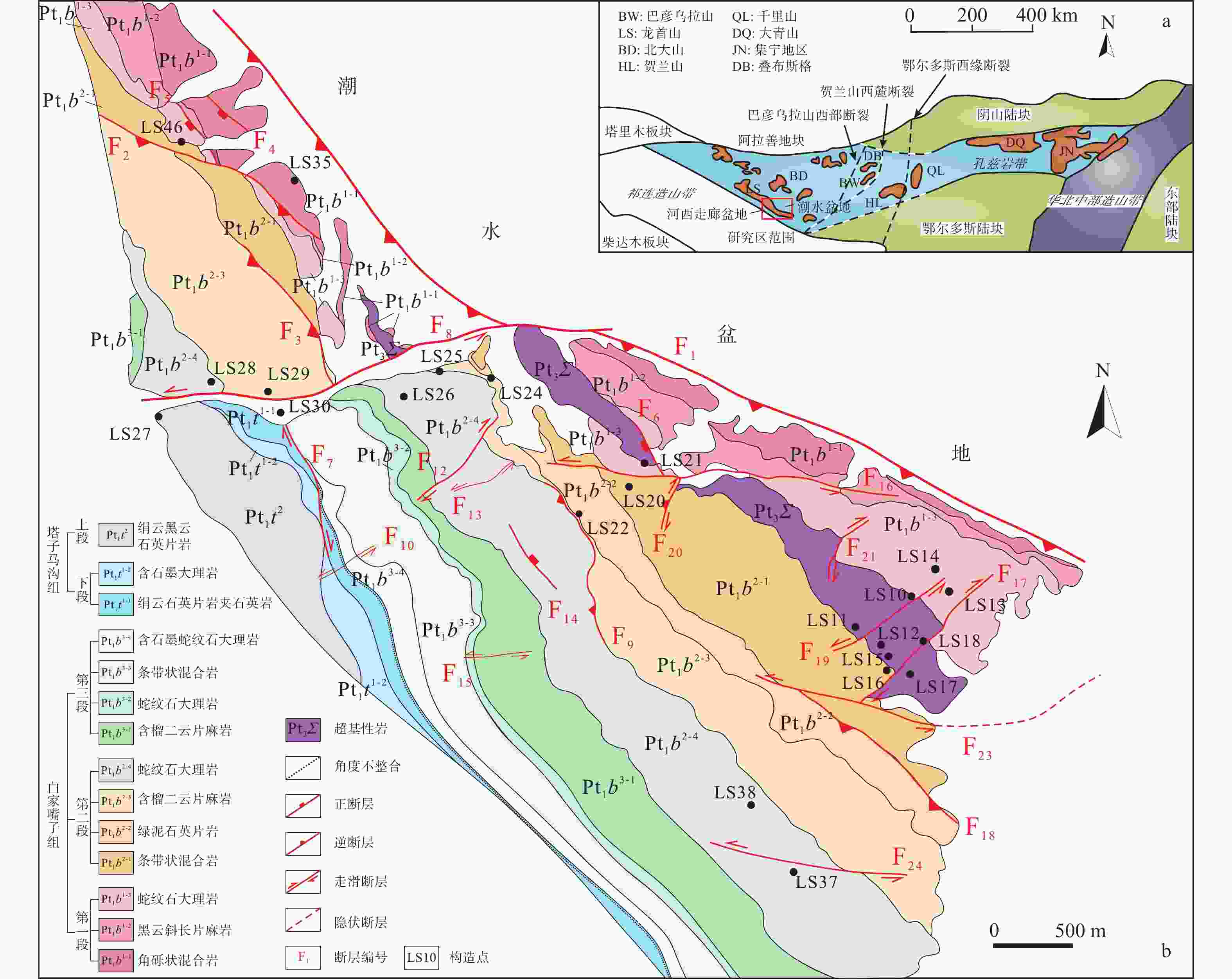
 下载:
下载:

